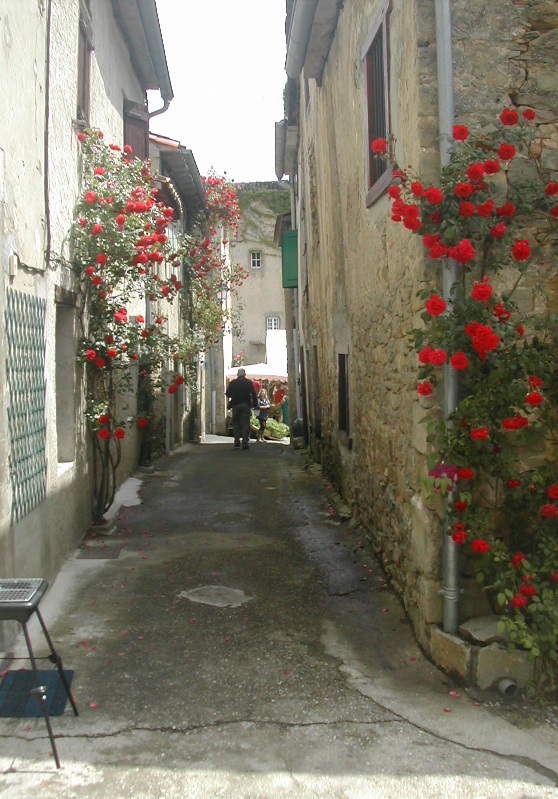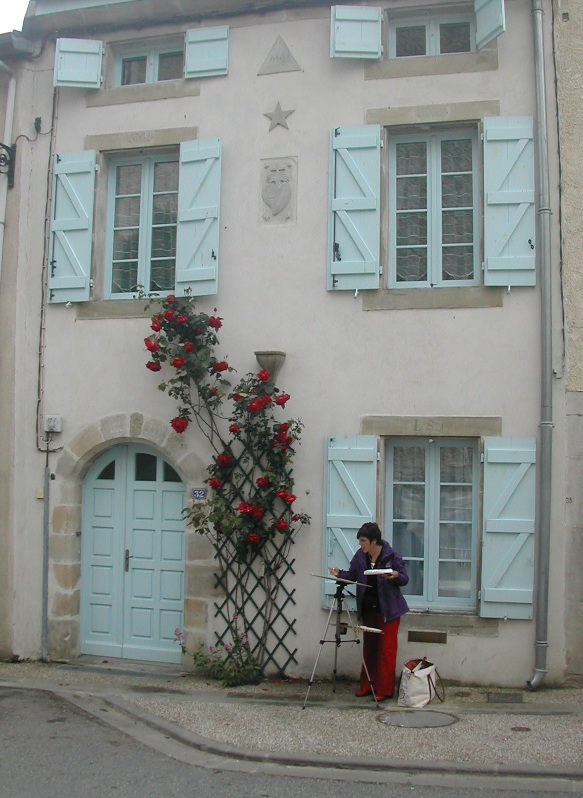A rose by any other name
The beautiful village of Camon has several honorary titles including “little Carcassonne” and “le village aux cent rosiers”. Camon actually boasts over 200 climbing and standard roses and most of the lovely village houses (including ours) have a rose scrambling up the façade. The village celebrates its roses in the annual Fête des roses which is held on the third Sunday in May.

Climbing roses adorn the house fronts in Camon's tiny streets within the bastide walls
Camon's display of roses is a strong visual reminder of the days when the hillsides surrounding the village were covered in vines. In places the terracing is still visible on the landscape and there are over 100 dry stone huts scattered around the village which were used by the agricultural workers for shelter or to store their tools. The peasants (note: this term has no derogatory associations locally) planted a single rosebush at the end of each row of vines to act as an early indicator of pests and diseases: a healthy rose promised a healthy grape harvest.
Large areas of the Ariège, from Toulouse in the north to the foothills of the Pyrenees in the south, were dedicated to winemaking. The wines produced were exported from Pamiers, which was an important inland port, to Bordeaux via inland waterways and the Canal du Midi. By 1882 the widespread outbreak of phylloxera, a disease which attacked the roots of the vine, had almost entirely wiped out wine production in the Ariège. The land which was once dominated by vines was subsequently used to raise beef cattle or to grow the crops which are still produced today: maize, wheat, sun-flowers, oilseed rape, and millet.
When we purchased la maison aux symboles I was concerned at the prospect of keeping our rose alive and well. As we only planned to visit the house 3 or 4 times a year I fretted about the rose being disfigured by nasty diseases or, worse still, expiring due to lack of water due to our lengthy absences during the hottest summer months. I was sceptical to say the least when I was told that the villagers would probably ensure that the rose did not die, however this is exactly what seemed to happen and the rose flourished. Unbeknown to me, Emilie V at the Office de Tourisme keeps a proprietorial eye on the health of all the village roses, replacing defaced or damaged name plaques and ensuring the roses are secured to the houses should they break free of their supports. On one occasion I recall being deeply impressed by Emilie's pluck and ingenuity at re-attaching our wayward rose to the house using wire and twine running between the first floor tête de bergère shutter fastenings.
I had carefully noted the name of the gorgeous, fragrant, deep red rose that climbs up the front of our Camon house from the name plaque that has been helpfully screwed to the façade by the Office de Tourisme. My intention was to buy the same rose variety in the UK and plant it at the British house we then called home, as a living and tantalising reminder of life in France. I was a little puzzled when I looked up Rosier Papa Meilland and read that it is regarded as one of the three great ultra fragrant red hybrid tea roses and is especially valued because the blooms stay a deep velvet red colour, turning a deeper burgundy red as the flower ages. I confess my knowledge of roses is not exhaustive but it looks a bit big to be a hybrid tea rose to me... My suspicions were confirmed when Emilie V confided recently that she believed that that our rose is not, in fact, a Rosier Papa Meilland but is more likely to be Etoile de Hollande.
“N'importe”, shrugged Emilie “the plaque is on the house now and they are very similar”
As she is saying this I can almost hear the hordes of rose aficionados sneeringly questioning the authenticity of the rose, whispering to each other that it looks more like an Etoile de Hollande to them.
Now even the rose name plaque is subject to scrutiny and I can't help but wonder if anything about la maison aux symboles is as stated on the “official” plaques mounted on the facade.

Rosier Papa Meilland as proclaimed on the plaque or could it be Etoile de Hollande? The mystery of la maison aux symboles deepens...